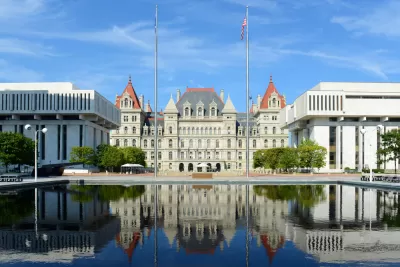Governor Kathy Hochul wants to build 800,000 new homes in New York in the next decade.

New York Governor Kathy Hochul took the occasion of the first State of the State address after narrowly winning election to the office in November to announce a statewide strategy designed to produce 800,000 new homes over the next decade.
A press release from the governor’s office describes the proposal, called the New York Housing Compact, as a “comprehensive, multi-pronged strategy,” which includes “local participation requirements and incentives to achieve housing growth in every community so that every part of the State is a partner in solving this urgent crisis.”
If that sounds like pro-development rhetoric of the YIMBY variety, you aren’t the only one to notice. An article by Henrey Grabar for Slate responded to the address with an article headlined “New York Has a YIMBY Governor.” Ross Barkan, writing for New York Magazine, notes that the proposals included in the State of the State address “would have been untenable for most politicians a decade ago.” Other publications, such as the New York Daily News and the Buffalo News, picked up on the implications of the proposal for the state’s suburban communities.
More specifically, Gov. Hochul’s proposed compact would require every town, city, and village in the state “to set a target number of new homes to create over a three-year period,” explains Denis Slattery for the New York Daily News. Yes, that means the status quo of exclusionary zoning is on notice. “The governor specifically called out suburban communities surrounding New York City for limiting building in recent decades and said in her address that the state is ready to step in,” adds Slattery.
Writing for the Buffalo News, Jonathan D. Epstein does the math to explain what the 1 percent increase in the housing stock of communities in upstate New York would look like.
Based on U.S. Census data, the mandate would mean four out of every five localities just need to permit 50 or fewer new housing units to meet the state-imposed target. And they will have flexibility on how they meet their goals, including redeveloping and repurposing underused office buildings or office parks, strip malls and industrial buildings, or offering incentives to encourage development of new apartment buildings.
And
For all of Erie County – which has 440,000 housing units, according to the U.S. Census Bureau – that means growth of 4,400 homes by 2026. In comparison, Erie County had 4,150 building permits for housing units during the three years from 2019 to 2021, according to federal data.
Writing for Slate, Grabar describes the New York Housing Compact as long overdue state action.
The Empire State is late to this party, though it’s not Hochul’s fault. New York has done virtually nothing to address its housing shortage over the past decade, even as California, Oregon, Washington, and Massachusetts—four other high-cost states—experiment with various ideas to override onerous local rules that restrict the supply of new homes.
Grabar also notes that some of the most notorious examples of housing discrimination from history played out in New York, including the events depicted in the HBO series Show Me a Hero and a book by the same name written by Lisa Belkin.

Planetizen Federal Action Tracker
A weekly monitor of how Trump’s orders and actions are impacting planners and planning in America.

San Francisco's School District Spent $105M To Build Affordable Housing for Teachers — And That's Just the Beginning
SFUSD joins a growing list of school districts using their land holdings to address housing affordability challenges faced by their own employees.

The Tiny, Adorable $7,000 Car Turning Japan Onto EVs
The single seat Mibot charges from a regular plug as quickly as an iPad, and is about half the price of an average EV.

Seattle's Plan for Adopting Driverless Cars
Equity, safety, accessibility and affordability are front of mind as the city prepares for robotaxis and other autonomous vehicles.

As Trump Phases Out FEMA, Is It Time to Flee the Floodplains?
With less federal funding available for disaster relief efforts, the need to relocate at-risk communities is more urgent than ever.

With Protected Lanes, 460% More People Commute by Bike
For those needing more ammo, more data proving what we already knew is here.
Urban Design for Planners 1: Software Tools
This six-course series explores essential urban design concepts using open source software and equips planners with the tools they need to participate fully in the urban design process.
Planning for Universal Design
Learn the tools for implementing Universal Design in planning regulations.
Smith Gee Studio
City of Charlotte
City of Camden Redevelopment Agency
City of Astoria
Transportation Research & Education Center (TREC) at Portland State University
US High Speed Rail Association
City of Camden Redevelopment Agency
Municipality of Princeton (NJ)





























